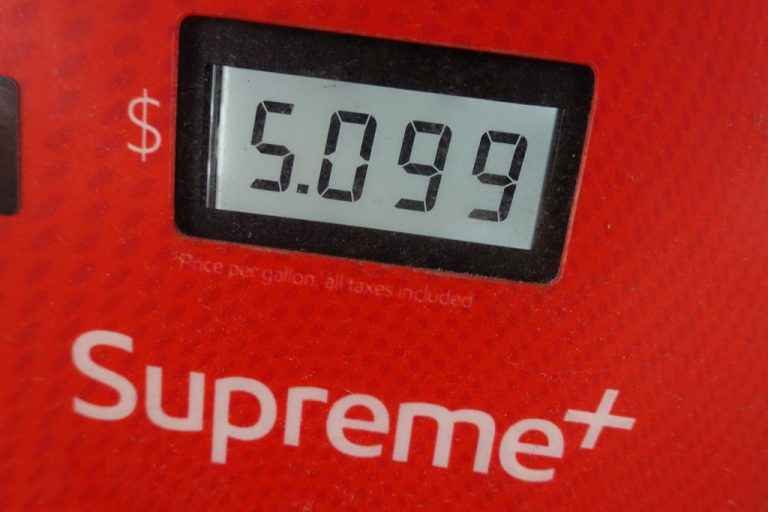Average gas prices are nearing the $4 per gallon mark due to unrest over the Ukrainian-Russian conflict, pushing inflation numbers to their highest levels in nearly 40 years.
As of Feb. 5, Americans were paying an average of $3.922 per gallon at the pump, the highest price in nearly a decade. Meanwhile, the price of crude oil has risen by almost 24 percent, pushing the inflation level to its highest in nearly 40 years—but the worst is likely yet to come.
Nationally, the price of gas increased by 9 cents in the span of a single day reaching the highest point since 2008, according to the American Automobile Association (AAA). The increase comes reportedly as oil supplies from Russia have been disrupted amid sanctions arising from the Ukrainian conflict.
“Russia’s invasion and the responding escalating series of financial sanctions by the U.S. and its allies have given the global oil market the jitters,” AAA representative Andrew Gross said in a statement.
However, not everyone buys the Russian explanation. Many more conservative media, such as Breitbart, suspect something else is going on.
Blame game
Success
You are now signed up for our newsletter
Success
Check your email to complete sign up
“The left-wing media is trying to blame inflation and rising gasoline prices on Russian dictator Vladimir Putin’s aggression toward neighboring Ukraine and cited the recent spike in Brent crude oil at $99.50,” the outlet attested last month.
Breitbart remarked that even though President Joe Biden promised last month to be “going to work like the devil to get gas prices down,” very little has happened so far to soothe the price hike apart from a “historic release of oil from the strategic oil reserves” in November last year
The measure had a very brief impact on oil prices, and so did the latest strategic oil release on Feb. 1 when the International Energy Agency unleashed 60 million barrels of oil from strategic reserves to the market in an attempt to alleviate prices.
READ MORE:
- SWIFT Drops Russia But Sanctions May ‘Backfire’
- German Chancellor Suspends Nord Stream 2 Pipeline After Putin Recognizes Renegade Ukrainian Territories
- Trudeau’s Ban on Russian Oil Imports Will Have Little Effect
However, the administration had full knowledge that the measure was a mere symbolic one—“a proverbial drop in the bucket,” as Raymond James analyst Pavel Molchanov put it, according to Forbes.
Counterproductive measures
In fact, the Biden administration has done close to nothing about the energy crisis, and with looming stagflation as a result—quite the opposite.
“Biden continues to push his anti-energy agenda, blocking key pipelines such as the Keystone XL project and trying to freeze new drilling on federal lands,” Breitbart complained, adding that the President’s push for electric vehicles won’t solve the problem either. The administration seems to have forgotten that most electricity is generated by burning fossil fuel.
“Unfortunately, politicians are clueless when it comes to gas prices,” said Patrick De Haan, head of petroleum analysis at GasBuddy app, according to AL.com. “Even President (Joe) Biden thinks he has some great influence over prices, but he doesn’t. A lot of the people that regurgitate these talking points are just misinformed.”
According to De Haan, gas prices will likely hit $4 a gallon again, he said.
“It’s really less a matter of ‘if’ but ‘when.’ It’s less because of a president and more because of what’s going on with Russia. We’re just in a tough spot right now.”
According to De Haan, the impact of the president’s moratorium on drilling in newly discovered fields will only be felt in a couple of years.
“The president is taking us down a road that will eventually lead to higher prices, but that exit will take two to three years for us to get to,” De Haan said.
Business as usual
Meanwhile, the European Union chose eggs for money by placing a record-breaking €689 million mega-order of Russian gas on March 2. Gas deliveries, for the moment, are still exempted from the Russian trade boycott.
According to the Associated Press, Russia provides 25 percent of Europe’s oil supply. A boycott on Russian gas and oil, either directly or indirectly by booting Russia from the SWIFT network, freezing all financial transactions making it impossible to trade, as considered by the western allies, would be outright disastrous and would send energy prices sky-high.
















